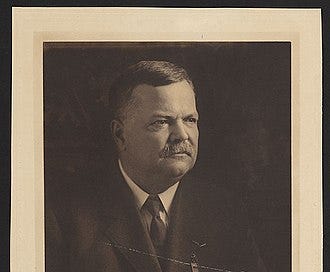Putting the justice into the Justice Department
What does it mean for the Department to do "justice"?
Sometime between 1910 and 1912, St. Louis attorney Frederick Lehmann, whom President William Taft appointed United States Solicitor General, uttered words now inscribed in the rotunda outside the United States Attorney General’s office: “The United States wins its point whenever justice is done its citizens in the courts.” (Katyal, 2011). While this is a noble ideal, it raises a significant question for which the answer is contested: What is justice?
When we talk about justice, we often use the term without considering its meaning. In fact, justice can mean different things to different people in different places at different times. Yet for the Department of Justice to “win its point,” we must determine a common meaning for the concept of “justice.”
In the classical, and most basic, sense, justice is ensuring that people receive what they deserve. This simple and straightforward definition begs a complicated question: how do we determine what any particular person deserves? In the criminal prosecution context this becomes particularly tricky as it asks whether a person has done something that is worthy of punishment. In other words, does a particular person deserve punishment?
Answering who deserves punishment requires three distinct inquiries. The first is a legal inquiry. We must determine if a law has been violated and whether that law is just. A just law would treat people equal people equally and not differentiate based on “morally arbitrary factors” such as race, gender or social status. (Werner, 2021). Whether a law has been violated is both a legal and factual question. The legal aspect requires that there be some evidence of every element of the offense. After all, we cannot have a burglary without someone unlawfully entering a structure. The factual aspect requires we determine if the person, in fact, committed the crime. In a sense, this is asking if we got the right person. This also requires that we answer a question about certainty. How certain are we that the crime WAS committed and we identified correctly the person WHO committed the crime?
Herein lies the problem for federal prosecutors. To do justice requires an exercise of judgment and discretion. Reasonable people can differ on the measure of certainty. They can also differ on the degree of certainly required. The law itself creates this problem. Prosecutors only need probable cause to charge someone but proof beyond a reasonable doubt to convict. Which standard of proof should prosecutors use? When different people look at the same case, they can reach different conclusions. Nor can prosecutors pursue every criminal violation. They must choose which defendants are worthy of punishment and which are not. Once again, reasonable people can disagree about who deserves punishment for particular conduct.
This disagreement leads to another issue: the perception versus the reality of justice. Philosopher Anthonfy Flew discussed this difference by defining fairness as people’s perception and justice is treating people equally. (Flew, 1985). This provides something of a resolution for prosecutors. While public perception is certainly relevant for both legal and political accountability purposes, prosecutors can proceed understanding that not everyone will be satisfied. So long as they treat people equally and not along “morally arbitrary factors” then they are fulfilling their mission to do justice.
To conclude where we began, Solicitor General Lehmann made his remark when he confessed to the Supreme Court that the lower court had made an error and that the Supreme Court must reverse the lower court, despite the lower court having ruled in the government’s favor. Perhaps, then, justice is simply a matter of making sure the prosecutors—and the courts for that matter—got it right. Of course, even getting it “right” is subjective!
I hope you enjoyed this issue and that it made you stop and think. I would love to hear any comments, questions, concerns, or criticisms that you have. Leave a comment or send a message! Also, if you enjoyed this or if it challenged your thinking, please subscribe and share with others!
Sources
Neal Katyal, “Remarks by Acting Solicitor General Neal Katyal,” 99 Georgetown Legal Journal 1317, 1322 (2011).
Lief Werner, “John Rawls” Stanford Encyclopedia of Philosophy, https://plato.stanford.edu/entries/rawls/ (2021) (viewed 9/20/2023).
Anthony Flew, “The Concept, and Conceptions, of Justice” 2 Journal of Applied Philosophy 191 (1985).




